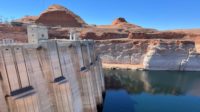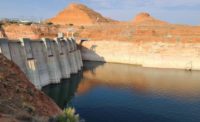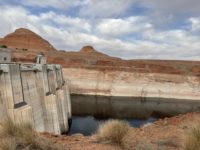With the western United States still recovering from a historic drought, lower basin states of the Colorado River are considering a plan designed to protect Lake Mead from dropping to critical levels that would trigger delivery reductions as Arizona formulates its own separate agreement on how to distribute its allocation.
The proposed interstate agreement, known as the Drought Contingency Plan, will define when insufficient supplies in the Colorado River will trigger restrictions to Arizona, California and Nevada. Arizona’s potential intrastate agreement is known as DCP-Plus.
The agreements will likely result in very little direct construction impacts, but it will further enhance certainty for current lower-basin inhabitants and allow for future business expansion and relocations, as well as population growth.
“We will be able to demonstrate to people and businesses that want to move here that we have the measures to combat (drought),” says Thomas Buschatzke, director of the Arizona Department of Water Resources. “The DCP between the states is essentially done. We have some lawyerly word sniffing to do but we are 99 percent done.”
He says thanks to 1980s legislation mandating guaranteed, 100-year water supply certifications for all new development and decades of “water banking” Colorado River water in aquifers, Arizona has not over-allocated.
“Our viewpoint is we are going to be more resilient compared to other places that have not done those things,” Buschatzke says.
Current Plans Based on 2007 Agreement
Lake Mead is the depository of Colorado River water that is distributed to California, Nevada and Arizona, also known as the lower-basin states of the Colorado River. Current agreements among the lower-basin states were established in 2007.
According to the 2007 agreement, when levels at Lake Mead dip below 1,075 ft above sea level based on a 24-month project and determined on Jan. 1, automatic triggers result for Nevada and Arizona.
If Lake Mead is declared below 1,075 ft above sea level, Nevada would experience a 4 percent cut of 13,000 acre-ft if Lake Mead reaches 1,075 ft. However, under the 2007 agreement, if Lake Mead drops below the restriction trigger level under the current agreement, impacts would be most felt in Arizona, which would have 370,000 acre-ft of water stripped from its annual allotment of 2.8 million acre ft.
At the AZ Water Association Annual Conference in early May, several key stakeholders participated in a panel discussion about the Drought Contingency Plan and why it is necessary to replace or augment the 2007 agreement.
According to all members of the panel, the goal for all Arizona stakeholders is to make sure Lake Mead does not drop below 1,075 feet, something that many think is unavoidable under the current agreement.
“It is paramount that we keep Lake Mead over 1,075 for as long as possible” says Paul Orme, an attorney who represents many agriculture-based clients and their water interests.
Highlights of New Drought Contingency Plan
Many expected the basin states to agree to the Drought Contingency Plan framework at the annual conference of Colorado River Water Users Association in December. That framework would have set a goal of insuring Lake Mead does not get below 1,025 ft above sea level and finding stabilization at levels above 1,045 ft.
The DCP framework also established a first-ever acquiescence from the state of California to phased reductions of up to 350,000 acre-ft that, as the senior water-rights holder, the state does not have to make.
The DCP framework also says “shortage” would be declared at 1,090 ft—above the current elevation—and Arizona would begin with a reduction of 192,000 acre-ft at the new shortage level.
If Lake Mead water levels continued to drop, Arizona would eventually lose 720,000 acre-ft in a series of incremental steps. At shortage levels in Lake Mead, Nevada would take an immediate cut of 8,000 acre-ft, eventually increasing to 30,000 acre-ft.
But as the framework did not find complete consensus, major Arizona stakeholder Central Arizona Project has floated additional changes, followed by dueling op-eds from CAP board members and Buschatzke in the local newspaper, the Arizona Republic.
“There have been major differences in opinion that have come out into the public sphere,” says Ted Cooke, general manager, Central Arizona Project.
Last week, however, all stakeholders regretted that so much of the process had made it into the public sphere.
“I think we will all get past that and find an agreement,” says Jason Hauter, attorney at Akin Gump Strauss Hauer & Feld, and who represents tribal interests in certain matters.
In addition to the DCP, Arizona stakeholders are also working on an internal Arizona agreement, known as DCP-Plus. That agreement would further refine how Arizona’s water-rights holders fulfill commitments made to the lower-basin states, specifically compensation for leaving water in Lake Mead and agreements on water banking.
“At the end of the day, (Central Arizona Project) and (Arizona Department of Water Resources) must find a way to benefit all of their stakeholders,” Cooke says.
Future Looks Wet, Wild
In March, the city of Phoenix entered into an agreement with the state’s largest holder of water rights, the Gila River Indian Community. The city is sending 3,800 acre-ft to the community’s updated Oldberg Dam Underground Storage Facility, east of Sacaton, Ariz. The facility’s aquifer has the capacity to hold 40,000 acre-ft.
If any construction projects come from DCP or DCP-Plus, Buschatzke says they will be similar pipeline and water banking projects.
“There are no specific construction project related to DCP or DCP-Plus but indirectly there are some things that will be built because of the DCP because of the commitments we made to the people of Arizona,” he says.
Most stakeholders, including Cooke and Buschatzke, agree that a finalized form of DCP and DCP-Plus will be presented for approval at the Arizona Legislature at the next session, beginning in January 2018.
“We are not as far away from an agreement as it may seem,” Cooke says.
According to Bronson Mack, spokesperson for the Southern Nevada Water Authority, Las Vegas’ water supply is relatively assured even in shortage situations. He says thanks to citywide recycling, conservation, construction of a third intake into Lake Mead, and current development of a $650 million low-level pumping station, the region is prepared.
The third intake into Lake Mead can provide water to the new pumping station when Lake Mead water levels drop to 875 ft, or 25 ft below where water can pass to delivery access points headed to California and Arizona.
“We feel we have been confident to take action from an infrastructure standpoint,” Mack says.





Post a comment to this article
Report Abusive Comment